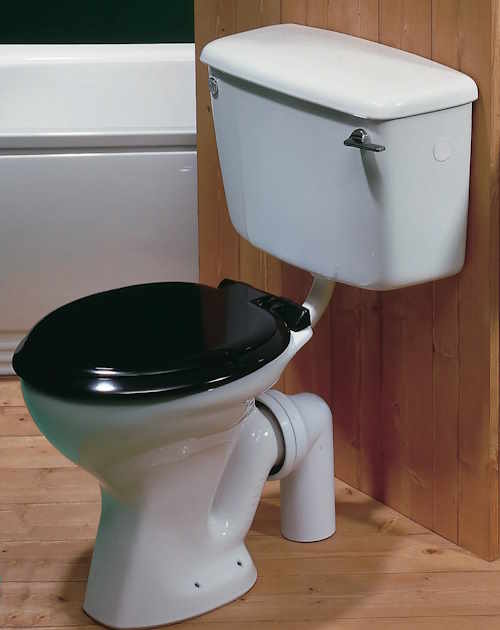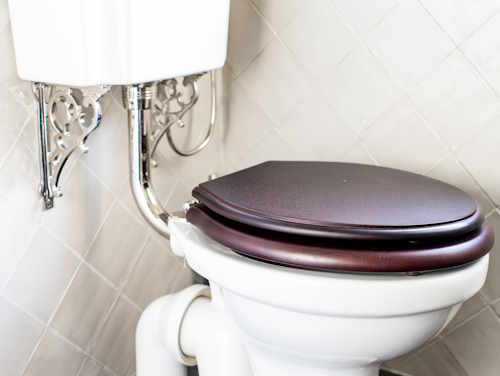Normally found in a period style setting,
this toilet design has the cistern and pan as separate items, connected together by a pipe. Flushing water flows through this pipe from the cistern into the pan.
Most basic utility toilets are low level (LL) and many traditional and period style toilets will be low level too.
Pros and Cons
Low Level pans are very simple designs and maintenance and repairs are fairly easy. Any leaks between the cistern and the pan are easily detected, and the flush pipe and seals can be removed, and replaced without having to remove the cistern from the wall or unbolt the pan from the floor.
The seat is easily removed and replaced, the fixing screws are simple to access.
The cistern lid is easy to remove to allow access to the flush mechanism and also fo the introduction of disinfectant blocks.
The pan connector from the outlet spigot to the soil pipe is easy to access and again any leakage is clearly visible.
Initial installation is straight forward as all the components are so accessible.
Normally available for not too much cost, with the exception of Period Style and Reproductions.
Tend to look a bit basic and utilitarian, unless the toilet is of a Period Style or of course a Reproduction Piece.
Although all the parts are easy to reach for cleaning, there are usually lots of nooks and crannies for dirt and grime to accumulate, so cleaning will be a more frequent chore.
When the soil pipe to a Low level WC comes up through the floor, it needs to be positioned further out from the rear wall than for a close coupled set. This can cause issues if the wc is to be changed in the future for a close coupled, particularly if the floor is concrete, as the waste will not connect without some additional work which could be extensive and thus expensive.


Many low level toilets, particularly traditionally styled types, use a lever flush with a siphon flush mechanism which uses larger amounts of water. They typical cistern of some years ago held around 8 litres of water, but modern cisterns will be set to hold only 6 litres and sometime a bit less.
Just to confuse the issue more recent lever flush toilets may be fitted with a cable action drop valve which will offer similar performance to a push button. It's worth checking out this detail before you buy. You can see more detail on flush systems here.
Here's a basic Low Level installation:

The seat and the flushpipe (connecting cistern to pan) are plastic and the flush lever is a fairly simple affair. You can however see that the seat fittings can easilly be reached for tightening or removal and that there is plenty of space around the back of the pan for access to the plumbing. Notice the small round disc on this side of the cistern near the top. This is a blanking disc which covers a point where the feed pipe can enter the cistern. Alternative feed entries are underneath the cistern, and often the feed can enter through the back just under the cistern lid. You can also se where the soil pipe connector bends down or a floor exit, and note the gap between the rear wall and the back of the pipe connector as referred to above.
Its clear from this photo that there is potential for the build up of dirt and grime around the rear of the pan making for a more frequent need to clean.
Next a slightly more stylish design:

This model shows a slightly more classical shape with the design detail around the top and base of the pan being echoed on the cistern lid. A slightly raised panel on the cistern front adds to the style and note the absence of any blanking plates on the cistern. ( there won't be one on the blind side either, I assure you). The feed to the cistern will be through the bottom , although there may be provision for an alternative back feed. The seat is a dark stained wood, the flushpipe is chrome plate and note the more stylish flush lever in a mix of ceramic and chrome.
The general smoothing of the shape of the pan makes for easier cleaning, but the accessibility for plumbing and seat removal remains. Expect to pay a wee bit more for one like this.
A classical style:

Here the use of mounting brackets for the cistern envokes a much more classical look. This is reinforced by the more rounded pan shape with the heavy rim dection at the top, and you can just see the shape detail on the cistern. The dark stained wooden seat and the chrome flushpipe ( and the ceramic/chrome lever out of sight) complete the classic look.
The pan is not a smooth in shape as that above but you can see that it is more streamlined and easier to maintain than the top image. Cost here will be mid range, largely brand dependent.
A full on reproduction toilet:

This is an accurate reproduction of an early style toilet, characterised by the pedestal section extending much further towards the front of the pan. The pan itself is quite rounded with some detail moulding at the top, just below the rim, and again in the base. However see how different the cistern is? Its not even white! The seat is in oak ane features an extended back section which covers the complete rear section of the pan, then the metal cistern mountings are fixed against oak wall mounts to enhance the style. Note the unusual flush lever, mounted front and center of the cistern which pulls forward to flush. You can probably just see the inlet blanking plate to the right top of the cistern, this is after all, a faithful reproduction of the original.
This particular toilet is manufactured by Thomas Crapper, a company named after the man accredited with the invention of the U-bend, who still use some of his original molds in the casting of their sanitary ware.


